Accepted Scientific Name: Sabal palmetto (Walter) Lodd. ex Schult. & Schult.f.
Syst. Veg., ed. 15 bis [Roemer & Schultes] 7: 1487 (1830)
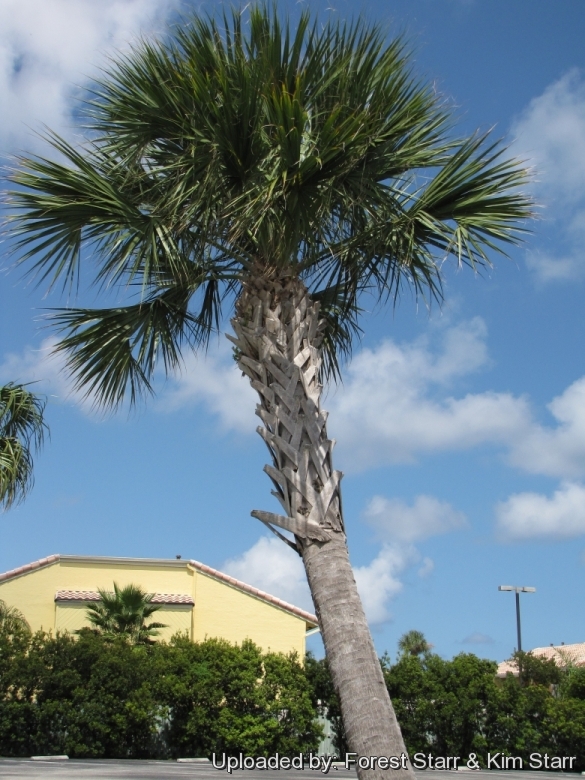
Chamaerops palmetto (Sabal palmetto) Photo by: Forest Starr & Kim Starr
Origin and Habitat: South-Eastern United States (Florida peninsula to the coast of North Carolina and Virginia), Cuba, and the Bahamas.
Habitat: It grows in sea-coast evergreen forests, barrier islands, coastal hammocks, sandy shores, tidal flats and elevated areas in brackish marshes in xeric to moist soil conditions. Climate is principally subtropical to warm temperate, humid with 1000-1770 mm of rain per annum, minimum and maximum temperature ranging from -4° C to 36° C.
Synonyms:
See all synonyms of Sabal palmetto
back
Accepted name in llifle Database:Sabal palmetto (Walter) Lodd. ex Schult. & Schult.f.Syst. Veg., ed. 15 bis [Roemer & Schultes] 7: 1487 (1830)Synonymy: 14
back
Common Names include:
ENGLISH: Sabal palmetto, Blue palmetto, Cabbage palm, Cabbage palmetto, Palmetto, Swamp cabbage, Sabal palm, Palmetto palm, Common palmetto, Carolina palmetto
ARABIC ( لعربية ): سابال بالمتو
CHINESE (中文): Ruo zong, Gan lan zong
FRENCH (Français): Chou palmiste, Palmetto, Chou palmiste à tronc bleu
GEORGIAN (ქართული): საბალი
GERMAN (Deutsch): Sabalpalme, Palmettopalme
HUNGARIAN (Magyar): Közönséges szabalpálma, Szabalpálma, Palmettópálma, Palmettó, Káposztapálma
JAPANESE (日本語): パルメットヤシ, キューバサバル, Parumetto yashi
KOMI (Коми ): Сабал
KOMI PERMYAK (Перем Коми ): Сабал
MARI (Кырык Мары / олык марий ): Сабал
PORTUGUESE (Português): Sabal-da-florida
RUSSIAN (Русский): Сабаль
SPANISH (Español): Palma cana, Sabal de Carolina, Palmito
UDMURT (Удмурт): Сабал
VIETNAMESE (Tiếng Việt): Cọ bắp cải
Description: It is a distinct fan palm with an upright solitary trunk.
Trunk: up to twenty metres tall, and a diameter of about 30-40 cm in the median area (with exceptional individuals up 28 m in height, with a trunk up to 60 cm), covered for a good part by the residuals of the old leaves petioles, which persist for a while near the crown and cross in a characteristic way creating a spiky, "basketweave" effect. These remnant leaf bases are called "bootjacks" or "boots". After shedding (or removing) of “bootjacks” the trunk appearas light-grey to gray-brown, relatively smooth, columnar, tough and splits vertically. Transplanted palms are sometimes deliberately shorn of these bootjacks. The trunk of the Sabal palmettoSN|24672]]SN|24672]] grows towards the sun and does not have any thorns or spikes. The underground part of the trunk is short and bulbous, surrounded by a dense mass of contorted roots.
Crown: Symmetrical, rounded, green, usually spreading between 2,5-5,5 m .
Leaves: Alternate, 2 m of length, rounded, green to dark-green, costapalmate (with a bare petiole which extends as a centre midrib, (costa) 1/2 to 2/3 the length of the blade), deeply cut in 40-60, generally rigid, segments up to 80 cm long, folded upwards and arranged radially like in a palmate leaf, filamentous at the margins and bifid at the extremity. Petiole unarmed, 1,5 metres long. All leaves are markedly recurved or arched backwards.
Flowers: The inflorescence is a very ramified cup shaped, compound panicle, up to 2,5 m long that grows between the leaves and normally does not exceed their length. The flowers in profusion are perfect (hermaphrodite), fragrant, 5-6 mm across, 3 mm long and of a creamy or yellowish colour.
Blooming season: Spring to summer.
Fruit: Nearly spherical fleshy drupe, 05-14 mm in diameter, dark shiny blue or black when ripe and containing a single seed, maturing in early fall and persistent into the winter.
Seed: Small, hard, shiny brown. Each Sabal palmettoSN|24672]]SN|24672]] will drop thousands to tens of thousands of seeds per year and if not properly pruned, will overgrow small plants or shrubbery in the area.
Notes: Florida designated the sabal palm (Sabal palmetto) as the official state tree in 1953.
Bibliography: Major references and further lectures
1) Wikipedia contributors. "Sabal palmetto." Wikipedia, The Free Encyclopedia. Wikipedia, The Free Encyclopedia, 12 Aug. 2014. Web. 11 Sep. 2014.
2) Forest & Kim Starr Sabal palmetto (cabbage palmetto, Florida palmetto). Plants of Hawaii. <http://www.starrenvironmental.com>. Downloaded on 21 August 2014.
3) John Dransfield, Natalie W. Uhl “Genera Palmarum: the evolution and classification of palms” Kew Pub., 2008
4) Don Ellison, Anthony Ellison “Cultivated Palms Of The World” UNSW Press, 01/May/2001
5) Govaerts, R. & Dransfield, J. “World Checklist of Palms”. The Board of Trustees of the Royal Botanic Gardens, Kew. 2005.
6) Palmpedia contributors. "Sabal palmetto ." Palmpedia, PALM ENCYCLOPEDIA, <http://www.palmpedia.net> Downloaded on 26 Aug. 2014
7) Robert Lee Riffle, Paul Craft “An Encyclopedia of Cultivated Palms” Timber Press, Portland 2007
8) "Sabal palmetto." PACSOA Palms and Cycads wiki , <http://www.pacsoa.org.au> Accessed on 28 Aug. 2014
9) Andrew Henderson “Field Guide to the Palms of the Americas” Princeton University Press, 1997
10) Zona, S. "A monograph of Sabal (Arecaceae: Coryphoideae)". Aliso (Rancho Santa Ana Botanic Garden) 12: 583–666.. 1990
11) Ernest Small “North American Cornucopia: Top 100 Indigenous Food Plants” CRC Press, 23/Sep/2013
12) Dr. John Anurag Panga “Plants of AMS Garden: A Garden in the Arabian Deserts of Dubai” Xlibris Corporation, 26/Aug/2014
13) Department of Commerce, Bureau of the Census, Center for Demographic Studies. “Social Indicators: Silvics of North America, volume 2, hardwoods” 1990
14) Alan McPherson “State Botanical Symbols” AuthorHouse, 2013
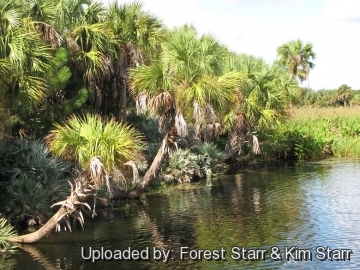 Chamaerops palmetto (Sabal palmetto) Photo by: Forest Starr & Kim Starr
Chamaerops palmetto (Sabal palmetto) Photo by: Forest Starr & Kim Starr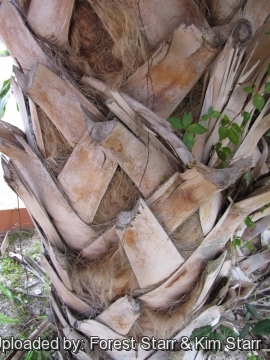 Chamaerops palmetto (Sabal palmetto) Photo by: Forest Starr & Kim Starr
Chamaerops palmetto (Sabal palmetto) Photo by: Forest Starr & Kim Starr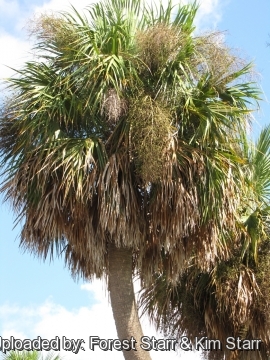 Chamaerops palmetto (Sabal palmetto) Photo by: Forest Starr & Kim Starr
Chamaerops palmetto (Sabal palmetto) Photo by: Forest Starr & Kim Starr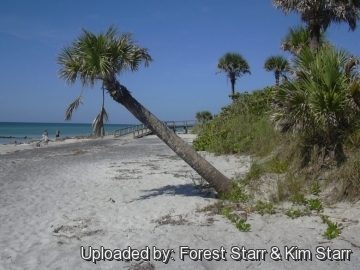 Chamaerops palmetto (Sabal palmetto) Photo by: Forest Starr & Kim Starr
Chamaerops palmetto (Sabal palmetto) Photo by: Forest Starr & Kim Starr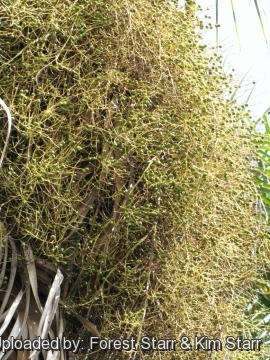 Chamaerops palmetto (Sabal palmetto) Photo by: Forest Starr & Kim Starr
Chamaerops palmetto (Sabal palmetto) Photo by: Forest Starr & Kim Starr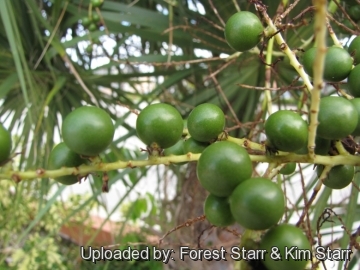 Chamaerops palmetto (Sabal palmetto) Photo by: Forest Starr & Kim Starr
Chamaerops palmetto (Sabal palmetto) Photo by: Forest Starr & Kim Starr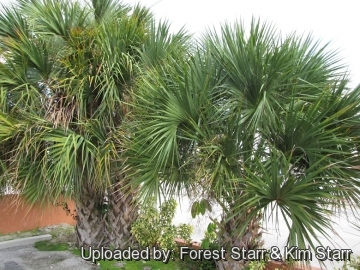 Chamaerops palmetto (Sabal palmetto) Photo by: Forest Starr & Kim Starr
Chamaerops palmetto (Sabal palmetto) Photo by: Forest Starr & Kim StarrSend a photo of this plant.The gallery now contains thousands of pictures, however it is possible to do even more. We are, of course, seeking photos of species not yet shown in the gallery but not only that, we are also looking for better pictures than those already present.
Read More... Cultivation and Propagation: This is an excellent palm widely cultivated, especially in the south of USA and in the Caribbean, for its ornamental characteristics and its rusticity. Sabal palmettoSN|24672]]SN|24672]] is very easy and very adaptable. It is little slow to take off but once established will grow quite fast and does well in cultivation.
Soil requirements: It has a fibrous root system and benefits from deep organic, soils that are fertile and well drained, but it adapts, in fact, to various types of tropical soil soils, like coastal marine alluvial clays, sand, soils of volcanic origin and other coastal alluviums and even in seasonally flooded areas and swamps.
Watering: It prefers regular moisture watering and regular feeding, but can tolerate temporary flooding or a fluctuating water table, as might be found along rivers and even drought, standing water and brackish water.
Light: Will take full sun as it matures, but will grow better with some shade. If home-grown, give some sun as with most tropical palms.
Fertilization: Need a perfect fertilizer diet including all micro nutrients and trace elements.
Salt aerosol tolerance: It is extremely tolerant to salt sprays and is often seen growing near the sea, but it do not tolerates saltwater flooding.
Hardiness: It is quite frost hardy and is suited for subtropical and warm temperate climate (can survive temperatures of 10°-20°F in its home habitat). (USDA zones 8-9 ).
Wind hardiness: It tolerates high winds and has good hurricane resistance.
Garden uses: It is an excellent landscaping palm able to grow where washed by sea water at high tide.
Food/beverage use: Sabal palmettoSN|24672]]SN|24672]] is one of several palm species that is sometimes used to make heart of palm salad. The heart of palm (vegetative apex) was particularly appreciated by the natives and was used fresh as a vegetable, from which the common name of cabbage or artichoke, but its collection, still practised, even if in a very limited extent in certain areas, causes the death of the palm, as it is the only point from which the plant can grow. In substitution to the traditional palmetto heart it is often used the palm heart obtained from Euterpe oleraceaSN|24491]]SN|24491]] which, since it clusters, can go on living to be harvested later, and it's pretty fast growing so it can replace the cut stems in a few years.
Insects and Diseases: Generally very healthy palm.
Propagation: The fresh seeds germinate easily in 2-3 month. If not properly treated, the seed does not have long shelf life.
















